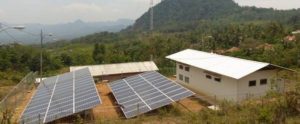 Mini-grids may finally be ready to change the world. But the small, self-sufficient electricity grids that connect communities who have not been reached by the main grid are not a new technology. In fact, the first grids were mini-grids. Edison and Tesla changed the world when they pioneered electrification with small privately-run grids, but eventually, the cheaper cost of large centralized grids quickly relegated mini-grids to a footnote in history.
Mini-grids may finally be ready to change the world. But the small, self-sufficient electricity grids that connect communities who have not been reached by the main grid are not a new technology. In fact, the first grids were mini-grids. Edison and Tesla changed the world when they pioneered electrification with small privately-run grids, but eventually, the cheaper cost of large centralized grids quickly relegated mini-grids to a footnote in history.
Now electrification is coming full circle. Due to the declining cost of solar and storage, mini-grids have fallen dramatically in cost and they may change the world again . A recent World Bank report found that mini-grid capital costs in Africa have declined by over 50% in the last 8 years, as “the costs of key mini-grid components, such as solar panels, inverters, batteries, and smart meters, have decreased by 62%–85% as a result of innovations and economies of scale in utility-scale solar projects, the booming rooftop solar industry, and the growing electric vehicle market”. Recent analysis has shown that these decreased costs mean that mini-grids are now the lowest cost way of providing power to at least 100 million people living off-grid in Africa.
Governments and investors have begun to recognize this potential and see that mini-grids have a critical role in achieving universal electricity access in Africa by 2030. In June, a group of investors with more than US$2 billion under management released a public position paper stating “we believe mini-grids have a role to play in achieving universal electrification, and we have the types of capital needed for mini-grid financing”. This was closely followed by representatives from 10 African governments – Côte d’Ivoire, Ghana, Kenya, Liberia, Nigeria, Zambia, Uganda, Zimbabwe, Tanzania, and Cameroon – echoing that call and appealing to governments, international donors and the private sector “to commit the capital required to de-risk the mini-grids sector and to do so in collaboration with international and domestic financial institutions.”
But despite this momentum, mini-grids have not yet begun to seriously scale across Africa. One of the main barriers to growth has been that the underlying assets are extremely hard to finance. Currently, most of the capital supporting the growth of the sector is venture and impact money. These investors should be commended for their courageous work in funding the high growth operating companies who are driving the mini-grid revolution. But, for this revolution to bring real change we will also need to unlock infrastructure capital from the natural long-term holders of infrastructure assets like pension funds, infrastructure funds, and insurance funds. Mini-grids are infrastructure assets and need long term infrastructure capital to scale.
Source: “Mini-Grids Are Ready To Change The World (Again)”, Forbes
